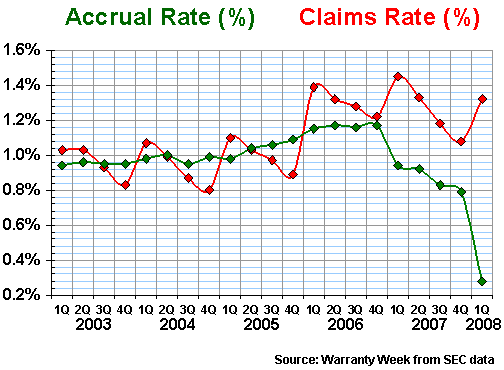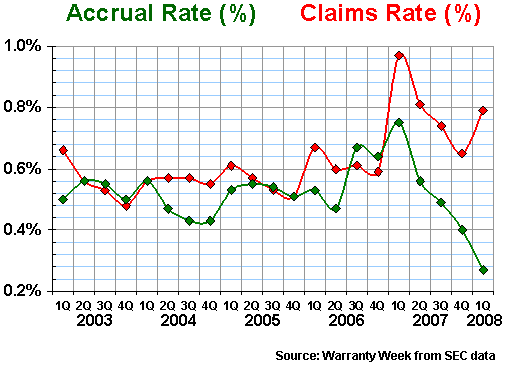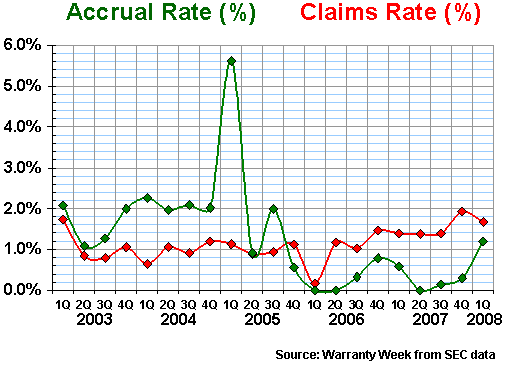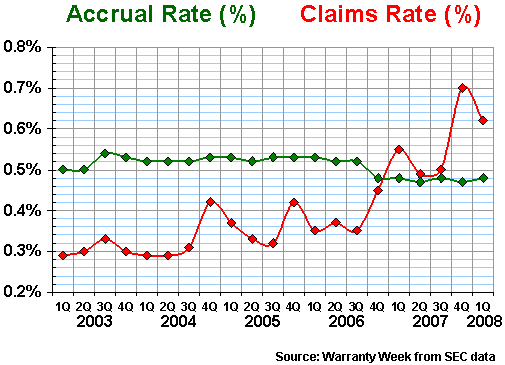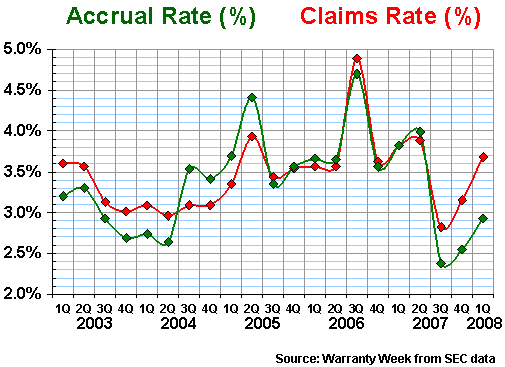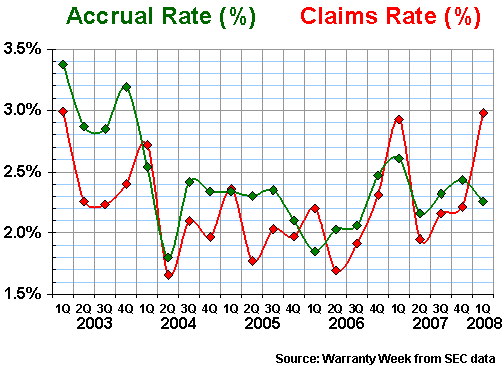RV & New Home Warranties:Sales are declining so claims rates are rising. But a few homebuilders have radically cut the amount they set aside per unit sold, raising suspicions that they're intentionally estimating low. Meanwhile, homes on wheels continue to show higher warranty costs.
While a few publicly-held new home builders seem to be cutting back on their warranty accruals in order to save cash and improve reported profits, most are weathering the industry downturn with their warranty accounts in good shape.
Were it not for U.S. accounting rules that force manufacturers to publish details about the additions and subtractions they make to their warranty reserves, outside observers would never be able to tell when a company has cut its accruals to conserve cash.
Last year, in newsletters published on August 8 and September 25, Warranty Week documented the beginnings of what seemed to be a noticeable downturn in warranty accruals by certain homebuilders. Sadly, in research looking at additional data through the end of the first quarter of 2008, it seems the problem might be getting worse.
Traditional Warranty Accounting
Fundamentally, a manufacturer is supposed to estimate the future warranty expense expected for a given product at the time of its sale, and is supposed to set aside that amount to finance future claims. The funds are placed into a warranty reserve, in the form of a warranty accrual. Normally, the estimates of a well-run manufacturing operation turn out to be close to actual expenses, but when they're on the low side, the company must make additional accruals to cover the shortfall. Conversely, when the estimates turn out to be higher than actuals, the company is free to withdraw the excess funds and turn them into profits.
Of course, a company that makes a low estimate will temporarily increase apparent profits, because funds that should have been placed into the warranty reserve are instead used for other purposes. And then, at some later date when the reserve is depleted, it can make what is positioned as an "extraordinary one-time charge" that cuts into profits dramatically. This is quickly forgiven by stock analysts, who will make their year-ago comparisons "excluding one-time charges."
There's no doubt that homebuilding is in a downturn in the U.S., with 42 of the 45 publicly-traded makers of recreational vehicles, mobile homes and site-built homes reporting annual sales declines in calendar 2007. Some, such as Avatar Holdings Inc., California Coastal Communities Inc., and WCI Communities Inc., have seen sales decline by more than half compared to calendar 2006.
And even though 2007 was a down year, the early returns from 2008 show the downturn deepening. Out of the 40 companies still in business during the first quarter of 2008, only six have seen sales rise compared to the first quarter of 2007.
Declining Home Sales
In Figure 1 below, we're tracking what seems to have been a peak in quarterly sales during the fourth quarter of 2005. Together, the 47 publicly traded homebuilders in business at the time reported $37.8 billion in revenue -- more than twice the $14.8 billion reported during the most recent quarter. And lest anyone dismiss that as a normal winter trough, we note that in the first quarter of 2003, sales topped $15.3 billion, making the most recent total the lowest since mandatory warranty reporting began.
Figure 1
RV & New Home Sales Revenue, 2003-2008
(in billions of dollars per quarter)
One would assume that warranty accruals would decline proportionally. For instance, if the estimate of future warranty expenses is $2,000 per home, one would expect the builder to set aside $1 million if they sell 500 homes, $800,000 if they sell 400 homes, or $200,000 if they sell only 100 homes. Warranty accruals would always be made at a rate of $2,000 per home sold.
If the selling price per home is at a constant $200,000 level, the warranty accrual rate would remain constant at 1%. In other words, 1% of sales revenue is put aside for each home sold. If the selling price were to decline to $180,000, the estimate of future warranty work would still be $2,000 per home. But the accrual rate would rise to 1.1%. Keep this in mind as you view the following charts: if home prices decline but repair costs do not, the accrual rate rises.
On the other hand, if the home is built better, or is built with more easily repaired materials, its manufacturer could reasonably predict that warranty costs would fall. So if let's say the builder estimates only $1,000 in future warranty costs, and cuts its accrual per home in half. If the selling price remains at $200,000, the accrual rate would fall to 0.5%.
Declining Warranty Accruals
As a group, RV manufacturers and homebuilders have been cutting their warranty accrual rate somewhat steadily for the past five years. In Figure 2, we've taken total accruals and divided them by total sales. For instance, in that peak quarter at the end of 2005, home manufacturers set aside $415 million -- also a peak amount -- in warranty accruals. But because sales were so plentiful, this equated to a 1.1% claims rate.
Readers will immediately notice that it was higher before that point and for the most part has been lower since. But as Figure 2 illustrates, it has slowly descended from a high of 1.3% to a low of 0.85%. And that 1.1% figure has been the average accrual rate for the 21 quarters covered by the chart.
Missing from the chart below is any measure of claims rates, but for the record they've followed a bowl-shaped curve. Claims were above 1% in 2003, at or below that level in 2004-2006, and once again above 1% in 2007 and so far in 2008. The industry average claims rate has been below the accrual rate for 15 of the past 21 quarters, but has been above it for six of the past nine quarters (which is typical during a sales slowdown).
Figure 2
RV & New Home Warranty Accruals, 2003-2008
(in percent of sales and millions of dollars)
We're not saying that anyone above 1.1% is putting too much aside or that anyone below 1.1% is putting too little aside to cover future warranty costs. Each company is different. Some are very good at pushing their warranty costs back onto their subcontractors and suppliers. Some make very large, expensive and well-built homes, while others make homes on wheels. And anyone making RVs or mobile homes is going to pay out much more than 1.1% in warranty costs, as Figures 7 & 8 illustrate. They're different products with different warranty characteristics.
And we can't compare companies against each other. One builder might issue two-year warranties while most others issue one-year warranties. Or different companies might include or exclude different costs from the warranty bucket, calling them something other than warranty costs. But, if one accepts that a given company is consistent over time, one can compare that company against itself over time.
Pulte Slashes Its Accrual Rate
In Figure 3, we've plotted the warranty claims and warranty accruals of Pulte Homes Inc. for the past five years, comparing the amounts reported for each to homebuilding revenues to calculate percentages. What's readily apparent is that claims vary by season, peaking in the winter months then sales are slow and claims are high, and falling in the autumn when sales are good and the homes are too young to generate many claims. But as was explained above, the accrual rate should always be proportional to sales, so it should follow a more or less straight line.
Instead, what we see below is a company that began to cut its accrual rate in early 2007 -- first by small amounts but lately by incredible amounts. In the most recent quarter, when Pulte was spending 1.3% of its revenue on claims, it set aside only 0.3% in accruals. Granted, claims are seasonal and we're also comparing new home revenue to claims on not-quite-so-new homes, but that has nothing to do with how much a company sets aside for every home it sells.
Figure 3
Pulte Homes Inc.
Warranty Claims & Accrual Rates, 2003-2008
(as a percentage of home sales revenue)
The other mathematical curiosity in the bunch is the Ryland Group Inc. For four years, claims and accruals more or less shadowed each other, intertwining at around the 0.5% to 0.6% level. But then in 2007, just as sales began to fall, and therefore claims rates began to rise, the company cut its accrual rate for four quarters in a row. Remember, claims are what happen to you while accruals are what you think will happen. Ryland must be expecting the total for claims per home sold to be cut in half in the near future.
Figure 4
Ryland Group Inc.
Warranty Claims & Accrual Rates, 2003-2008
(as a percentage of home sales revenue)
And then there's Beazer Homes. The company only recently caught up on some late filings of financial reports for 2007, which revealed that for the third time in two years the company made no quarterly accruals at all. This means the company sold homes during those quarters that it believes will never incur warranty claims (or that it sold no homes at all). If it had determined that there was excess cash in the warranty reserve, it would have removed them through a negative change of estimate. But if it sold a home, it should have separately put 1% or 2% of that revenue aside (whatever it believes it will cost in the future).
When a company makes no accruals yet it pays claims, the warranty reserve balance shrinks a bit, because funds are withdrawn but deposits are not made. But this also has the effect of making earnings look better, or at least it makes looses look smaller, because the reserve money is spent but the funds are not replaced. Beazer has $47.1 million in its warranty reserve now, so there's no danger of it running out any time soon. But that balance is down by $10 million from six months ago and has fallen by nearly $42.4 million in the past year.
Figure 5
Beazer Homes
Warranty Claims & Accrual Rates, 2003-2008
(as a percentage of home sales revenue)
Sales at Beazer were down by 39% in calendar 2007 and were down by 48% in the first quarter of 2008, compared to a year previously. Ryland has seen sales fall 36% for the full year and by 42% for the most recent quarter. Pulte saw a 35% decline in calendar 2007 and a 24% decline in the first quarter. But again, absent any breakthroughs in product quality or massive increases in home prices, the accrual rates should have remained the same.
Keeping Accruals Steady in a Downturn
In Figure 6, we're selecting D.R. Horton to illustrate what should happen as sales volumes fall. It could just as easily have been Lennar Corp. or KB Home or Toll Brothers or any other homebuilder that has kept its accrual rate steady as sales declined and claims rates rose. but what you see below is a more or less straight line for accruals that's just slightly above 0.5% or slightly below 0.5% for the past five years.
Meanwhile, the claims rate has risen steadily. This is no great achievement -- it would be better if both lines were flat or at least close together. But that's what happens when sales decline, and you have to repair last year's homes with this year's revenue.
Figure 6
D.R. Horton Inc.
Warranty Claims & Accrual Rates, 2003-2008
(as a percentage of home sales revenue)
The point is that at least four homebuilders have maintained a relatively steady accrual rate as sales declined and claims rates rose. And at least three homebuilders have made curious cuts in their accrual rates that look all the more curious when compared to Figure 6. Again, we're not saying that 0.5% or 1.0% is the "right" accrual rate. What we're saying is that absent some breakthrough in quality or a free-fall in repair costs, the accrual rate should remain relatively steady over time.
Higher Rates for RVs
Finally, below are two examples from the RV industry, which illustrate two points. First, the makers of prefabricated homes, mobile homes, and recreational vehicles have to live with much higher claims and accrual rates than do the builders of site-built homes. And second, even in the face of volatile changes in claims rates, it's possible to adjust accrual rates up and down to compensate.
Normally, we include Fleetwood and Thor in the automotive category, along with all the OEMs making trucks, buses, farm equipment, and construction vehicles. In that company, claims rates of 3% or 4% are typical, though anything above 5% is high and anything below 2% is unusual. As seen in Figure 7, Fleetwood Enterprises has seen both extremes in the past five years.
Figure 7
Fleetwood Enterprises Inc.
Warranty Claims & Accrual Rates, 2003-2008
(as a percentage of sales revenue)
Thor Industries has kept its highs and lows within a much narrower range (the scale of these charts somewhat exaggerates the movements). In Figure 8, we see a company that only occasionally strays outside the 2.0% to 2.5% range, though it did so in its most recent financial report. But here's a shocker: Thor's sales were up by 3% in the first quarter of 2008, and were down by only 5% last year. Fleetwood, Monaco and Champion Enterprises were down by both measures, though Winnebago Industries saw a 6% sales gain in 2007.
Figure 8
Thor Industries Inc.
Warranty Claims & Accrual Rates, 2003-2008
(as a percentage of sales revenue)
Again, it would be better if these were flat parallel lines, but not every company can achieve that kind of consistency for their product line. And what's encouraging to see is that the accrual rate rises before the claims rate, which means the company is anticipating the increased costs by ratcheting up accruals at the time of sale, which is a few months before the customers make the actual claims. This is what's supposed to happen, and this is what almost every company says it does: adjust estimates to reflect actuals.
| 




